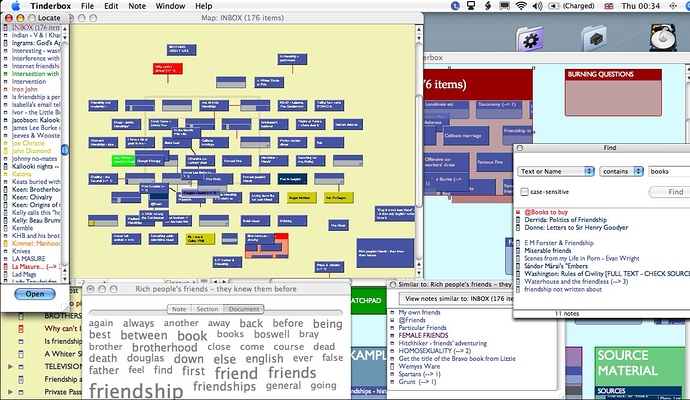Hallo. As a researcher, I have many notes on related but different subjects. In your opinion is it better to set a unique doc with many containers or split different containers in many different docs? Albeit the number of notes will (hopefully) grow very fast, this is not a problem at the moment, because I am starting now to use TB.
Thank you for your opinion.
TG
If the notes in a document are (or potentially could be) related to one another, or to the same topic(s), or be useful to see conveniently in the same map(s) or other views, or if you have any droubt about whether to split up a document, then stay with a single document. There are many customers here, and @eastgate, who have discussed their work with very large and complex Tinderbox documents, with few or no concerns. As long as you have adequate computing power, I wouldn’t be concerned about size. In my own experience it is better to let a document grow large than to try to consolidate documents — since consolidation often involves fiddling with making prototypes, templates, key attribute settings, etc., work in the consolidated document.
Thank you very much PaulWalters. Which is the better way to consolidate my three different TB docs?
I used to create some Alfred shortcuts to open quickly 5 different docs: lec for my reading notes or j for my journal, for instance. But since I decided to separate my notes into two big files, one for my readings, the other for my notes and projects, I have now two shortcuts and it is very convenient. But you don’t need to have Alfred for that. I talked about it yesterday and it’s here. You’ll certainly find some good suggestions here too. I like the idea to see my tags growing with time and be connected between each other in a big file. I think I have in mind the writing project behind this picture you probably know:
The image produced by Tinderbox 4.5 shown in the image shown above is very interesting – but it is also not what Tinderbox 6 or Tinderbox 7 do. Just mentioning this in case some readers who attempt to reproduce the layout are frustrated when they cannot set up their own documents that way.
Consolidation depends on the documents you’re working with, but just make sure that the document you are moving notes into has the same prototypes, templates, link definitions, and user attributes defined as the documents you are moving notes from. Make sure the prototypes and templates are in the same containers as they are in the source document. If you have used some Tinderbox built-in prototypes or templates and then customized them (e.g., changed the key attributes list for a prototype) then be sure the make the same changes in your destination file.
All of these things can be handled after you copy / paste notes into the destination document, but it is a lot simpler if they are taken care of in advance. A lot less time spent cleaning up. One approach is to consolidate from smaller documents (fewer notes) into the largest document – saves time.
Your maps and links might not carry over well or at all.
You are right and your advices are suitable. My intention was to stress some aspects of my own relationship to what was Tinderbox when I discovered it in 2009. Most of the time, digital tools seem to have no remembrance of their own history, as if they were Argo’s ship. Personally, I look at this picture with great pleasure: it makes me remember the hope I put in Tinderbox: working, in the forthcoming years, to a vast writing project.
